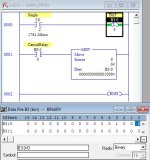Good morning all,
I'll preface this by saying I've been an electrical tech for about 10 years, but just started doing programming in the last two years. I'd say I'm still beginner to maybe starting to hit intermediate levels so I still miss some of the simpler concepts.
I'm currently working on a robotic packaging cell, the cell provides the product and boxes to pack on separate infeed conveyors. The issue I'm experiencing is that when I have a Box jam on the Infeed, the minor fault does not seem to want to reset all the time.
Our programs are designed over in Italy and it's up to us to interpret them so it presents its own challenge - but we're ultimately responsible for debugging and fixes so this is one I definitely need to get the concept of pretty quickly.
When looking at the logic, we have several sensors in a series with a filter (5 seconds filter) to check for jams, each sensor uses an XIC and if all them are high at the same time under certain conditions for longer than five seconds the system says okay, we have a jam on the infeed box conveyor please check and remove the jammed box. And you cannot resume the operation of the work cell until the jam is cleared.
This minor fault is turned on with an OTL, but when I am looking to see how it is unlatched I don't find an OTU specific to the tag used for the OTL. I believe they generally have a general reset pulse that is set to unlatch all alarms if their conditions are not met for the alarm to go high.
Is it possible that this is part of the reason why we seem to struggle with this particular alarm if it doesn't have an OTU to accompany the OTL?
This is all Allen Bradley btw, on Studio Logix 5000 using version 33.
I'll preface this by saying I've been an electrical tech for about 10 years, but just started doing programming in the last two years. I'd say I'm still beginner to maybe starting to hit intermediate levels so I still miss some of the simpler concepts.
I'm currently working on a robotic packaging cell, the cell provides the product and boxes to pack on separate infeed conveyors. The issue I'm experiencing is that when I have a Box jam on the Infeed, the minor fault does not seem to want to reset all the time.
Our programs are designed over in Italy and it's up to us to interpret them so it presents its own challenge - but we're ultimately responsible for debugging and fixes so this is one I definitely need to get the concept of pretty quickly.
When looking at the logic, we have several sensors in a series with a filter (5 seconds filter) to check for jams, each sensor uses an XIC and if all them are high at the same time under certain conditions for longer than five seconds the system says okay, we have a jam on the infeed box conveyor please check and remove the jammed box. And you cannot resume the operation of the work cell until the jam is cleared.
This minor fault is turned on with an OTL, but when I am looking to see how it is unlatched I don't find an OTU specific to the tag used for the OTL. I believe they generally have a general reset pulse that is set to unlatch all alarms if their conditions are not met for the alarm to go high.
Is it possible that this is part of the reason why we seem to struggle with this particular alarm if it doesn't have an OTU to accompany the OTL?
This is all Allen Bradley btw, on Studio Logix 5000 using version 33.




